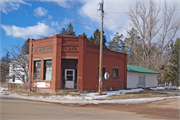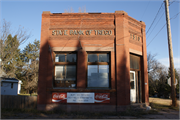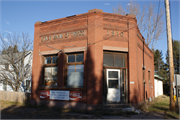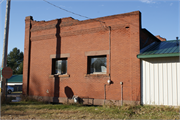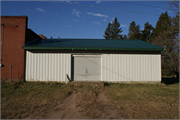Property Record
W5630 OAK HILL RD
Architecture and History Inventory
| Historic Name: | State Bank of Trego |
|---|---|
| Other Name: | Trego General Store |
| Contributing: | |
| Reference Number: | 18084 |
| Location (Address): | W5630 OAK HILL RD |
|---|---|
| County: | Washburn |
| City: | |
| Township/Village: | Trego |
| Unincorporated Community: | TREGO |
| Town: | 40 |
| Range: | 12 |
| Direction: | W |
| Section: | 35 |
| Quarter Section: | SW |
| Quarter/Quarter Section: | SW |
| Year Built: | 1910 |
|---|---|
| Additions: | 1926C. 1960 |
| Survey Date: | 1976 |
| Historic Use: | bank/financial institution |
| Architectural Style: | Commercial Vernacular |
| Structural System: | |
| Wall Material: | Brick |
| Architect: | |
| Other Buildings On Site: | |
| Demolished?: | No |
| Demolished Date: |
| National/State Register Listing Name: | Not listed |
|---|---|
| National Register Listing Date: | |
| State Register Listing Date: |
| Additional Information: | A 'site file' exists for this property. It contains additional information such as correspondence, newspaper clippings, or historical information. It is a public record and may be viewed in person at the Wisconsin Historical Society, State Historic Preservation Office. CORBELLED BRICK TRIM. CUT-AWAY DIAGONAL ENTRY AT CNR. CORNERS W/BRICK PILASTERS W/CORBELLED TRIM AT CAP. DOOR W/SIDELIGHTS AND TRANSOM. HEAVY CUT STONE SILLS AND LINTELS. 2008- "The State Bank of Trego Building stands on the northwest corner of Oak Hill Road and Second Street in Trego, approximately 0.25-mile east of USH 53 (Figure 6). Oak Hill Road passes along the south side of the property. On site, a short dirt drive enters the property from Second Street. No other buildings, structures, sites or objects are located on the property. The land around the State Bank of Trego Building is in residential and commercial use, with mostly residential resources dating from the early twentieth century. The State Bank of Trego is rectangular in plan, measuring about 25 feet (east-west) by 50 feet (north-south). A parapet hides the roof, and displays brick corbelling, and raised letters reading STATE BANK OF TREGO, and the construction date, 1910. Heavy brick pilasters enriched with brick corbelling anchor the corners of the building on both the south-facing (front) fagade and east-facing fagade. The entrance is found in the canted, southeast corner of the building. The south-facing (front) facade is three bays wide and overlooks Oak Hill Road. It possesses two broad, two-over-two windows surmounted by two-pane transoms. The entrance is composed of a door, flanked by two-pane sidelights, surmounted by a deep, two-pane transom. A small set of concrete stairs rises to the entrance. The top step displays small, white, square tiles, which surround the word BANK, spelled out in black tiles. The gabled, frame addition is appended to the north-facing (rear) facade. It rests on a cement block foundation and has recently been sided with standing seam metal, which also covers the roof. While it is largely devoid of any openings, there is one overhead garage door on the east-facing fagade of the addition. The addition appears to date from ca. 1960 with alterations (standing seam metal) dating to ca. 2008. Two, small single-pane windows can be seen on the east-facing (Second Street) facade. Each is accentuated with a plain stone sill and lintel. At the roof, portions of the parapet have fallen. There are no openings on the west-facing facade. Although the interior was not accessible during the field review, the glass front door provided a visual inspection. The interior has not been subdivided and remains one large open room. The original wooden board flooring is still in place, as well as some ceiling and plaster finishes. Although there is no visible evidence of the building's historic bank use, the majority of the building's historic interior finishes remain intact. ALTERATIONS Exterior alterations are predominately limited to the addition on the north-facing (rear) fac;ade. The addition is a non-contributing element, but its placement to the rear of the bank minimizes its impact. Elsewhere, the bank retains good integrity. On the exterior, the original windows and front door remain intact. The interior has not been remodeled. The addition nonwithstanding, the State Bank of Trego retains a high degree of integrity. SIGNIFICANCE: COMMERCE/TRADE Trego, a small unincorporated community in central Washburn County, established itself in the late nineteenth century after the arrival of the Chicago, St. Paul, Minneapolis & Omaha Railroad. In 1881, the "Omaha Road" began construction of a branch toward Ashland from a new station called "Superior Junction." Eventually, a tiny settlement grew up around the Superior Junction station (now known as Trego) to support the railroad, local lumbering and agricultural interests. By 1895, the community of Superior Junction became known as Mills, and a general store was its sole business. By 1903, two general stores, two liveries, and two saloons comprised the commercial sector of Mills, and in 1904, the plat of Mills was recorded. The name was changed to Trego in 1906. The State Bank of Trego was erected in 1910. By 1911, Trego had an estimated population of about 100, and had added a blacksmith and a potato warehouse to its businesses. By 1915, a farm implements store was in operation in Trego, and the community had telephone service. Trego continued to grow slowly into the 1920s. By 1924, it had an estimated population of about 200. The commercial sector was composed of three general stores, a blacksmith, a saloon, a hotel, a feed and grist mill, the bank, an auto sales and repair shop, and a lumber company. By the mid 1920s, however, as an economic recession spread throughout the Wisconsin agricultural industry, the local economy of Trego- like many small communities throughout Wisconsin- began to fail. Because small rural banks like the State Bank of Trego were tied to the local economy, if that economy weakened significantly, the bank often failed. Bank failures were very common throughout the state during this time, and in fact, the great majority of bank failures in Wisconsin were west and north of a line drawn from Green Bay to the southwestern corner of the state. During this recession, many borrowers were simply unable to meet their obligations and the banks soon found themselves with frozen or worthless assets. Although commonly attributed to the general decline of agriculture, rural bank failures were also connected to revolutionary changes in business processes and mercantiling. In Washburn County, dairying, raising livestock and feed crops, and cultivating cranberries and potatoes were carried out with limited success, but the land was generally poor for agriculture. As a result of the recession, Washburn County banks in Minong, Springbrook and Shell Lake fell victim to the times and closed. While the factors listed above certainly laid the framework for the 1926 closing of the State Bank of Trego, perhaps the automobile played the biggest role in its demise. Better roads enhanced the commercial importance of larger towns. Residents were no longer limited to Trego for their basic needs, and could travel to nearby towns offering expanded services, like Spooner. Another event that reputedly hurt Trego was the establishment of large potato farms that had the financial advantage of economies of scale over smaller, local growers, and whose cultivation practices depleted the soil. After the bank's closure, the State Bank of Trego building was used as a general store into the 1980s. The building is significant to the local community for its long usage as the focus of commerce for Trego. During its heyday (early 1920s), Trego boasted three stores, four saloons, a hotel, a blacksmith shop, a wagon maker, two livery barns, a feed and grist mill, the bank, a dance/pool hall, three potato warehouses, a jail, a lumber company, an auto sale and repair shop, and a barber. Aside from the State Bank of Trego building and one additional altered commercial building from the same era, no visible evidence of Trego's commercial center remains. Although no longer functioning as a bank or a general store, it clearly conveys its historic association with early twentieth century banking in Wisconsin, and also its use as a general store, which continued to operate in the former State Bank of Trego well into the 1980s." -"State Bank of Trego", WisDOT#1195-00-02, Prepared by Rachel E. Bankowitz, Commonwealth Cultural Resources Group (CCRG), (2008). 2008- "The State Bank of Trego is located on the northwest corner of Oakhill Road and Second Street in the community of Trego. The bank is a one-story, brick, Commercial Vernacular building, set on a stone foundation. A parapet hides the roof, and displays brick corbelling, and raised letters reading: STATE BANK OF TREGO, and the construction date, 1910. Heavy brick pilasters enriched with brick corbelling anchor the corners of the building on both street facades. The entrance is found in the canted, southeast comer of the building. It is composed of a door, flanked by two-pane sidelights, surmounted by a deep, two-pane transom. The south-facing (front) fa9ade overlooks Oakhill Road. It possesses two, broad, 2/2 windows surmounted by two-pane transoms. Two, small, Ill windows can be seen on the east-facing (Second Street) facade. There are no openings on the west-facing facade. A gabled, frame addition attaches to the north-facing (rear) facade. It appears to date from c. 1960." -"USH 53: WIS 70 to 0.75 miles north of Schnagel Rd", WisDOT#1195-00-02, Prepared by Elizabeth L. Miller, (2008). |
|---|---|
| Bibliographic References: | Cornice. |
| Wisconsin Architecture and History Inventory, State Historic Preservation Office, Wisconsin Historical Society, Madison, Wisconsin |

